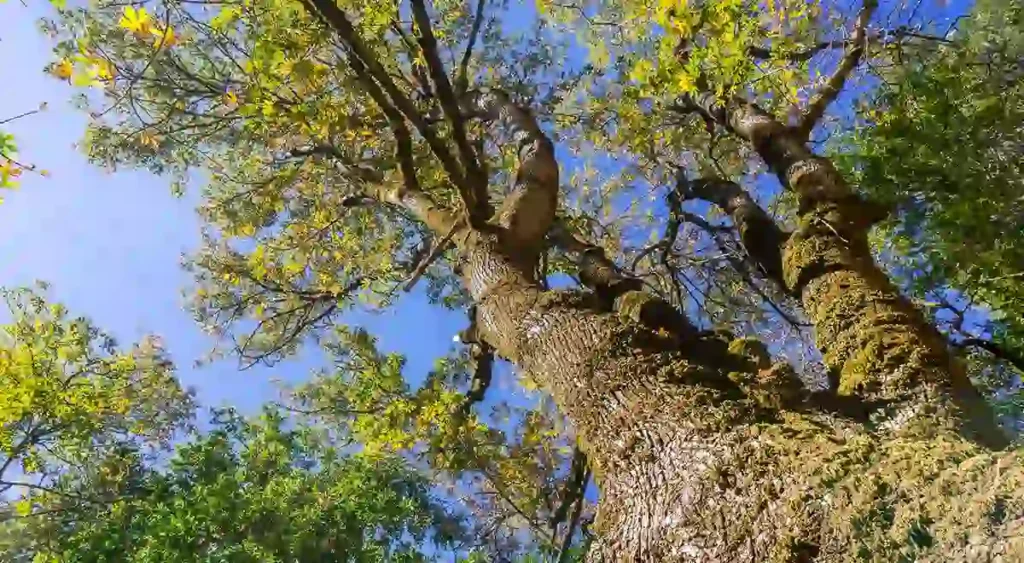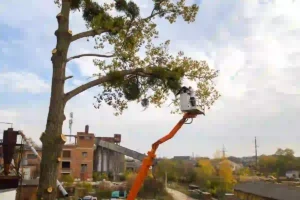Tree care can be expensive. Especially for emergencies. That’s why it is critical to budget seasonal maintenance costs so tree service jobs don’t pop up when you least expect them. Read more to learn how to budget for seasonal tree maintenance costs.
On average seasonal tree maintenance runs $300-$800 annually for typical residential properties with 3-5 trees. Here’s just a few of the most common seasonal tree maintenance costs:
– Spring inspection and fertilization ($150-$250).
– Summer pest monitoring ($100-$200).
– Fall structural pruning ($200-$400).
– Winter storm cleanup as needed ($0-$300 depending on weather).
Properties with more or larger trees run $800-$2,000 annually.
Go to treetrimmingcostcalculator.com to estimate costs for your specific trees and location. Input tree counts, sizes, services needed. Calculator provides seasonal cost breakdowns helping you budget monthly or annually.

Why Seasonal Budgeting Actually Matters
Tree maintenance can’t be delayed without consequences. Skip spring treatments? Pests establish. Skip fall pruning? Winter storm damage risk increases. Skip summer monitoring? Miss disease early stages. Each delayed season compounds problems requiring more expensive corrections later.
Annual maintenance costs less than periodic crisis management. Spending $500 annually prevents $3,000 emergency removals. Budgeting seasonally spreads costs across the year making them manageable rather than facing large unexpected bills.
Seasonal scheduling secures better pricing. Winter pruning costs 20-30% less than summer pruning. Planning seasonal work during each season’s optimal pricing window maximizes budget efficiency.
Property values depend on tree health. Well-maintained trees add 5-20% to property values. Neglected trees decrease values and create hazards. Seasonal budgeting protects your investment.
Spring Season Budget Items
Spring inspection costs $75-$150 for properties with 3-5 trees. Certified arborists examine trees for winter damage, emerging pests, disease signs, structural issues. Early detection prevents expensive problems later.
Fertilization runs $50-$200 per tree depending on size and method. Spring feeding supports active growth season. Trees store nutrients for summer stress periods. Surface application costs less. Deep root injection costs more but delivers nutrients more effectively.
Minor pruning for storm damage cleanup adds $100-$300. Winter storms break branches. Spring cleanup removes hazards before leaves emerge and hide them. Small jobs handle easily in spring before summer demand spikes.
Pest prevention treatments cost $75-$200 per tree. Emerald ash borer, tent caterpillars, scale insects all activate in spring. Preventive treatments applied before infestation cost less than treating active infestations.
Mulch refreshing runs $50-$150 for typical yard. Add 2-4 inches of fresh mulch after removing excess buildup. Mulch regulates soil temperature and moisture through growing season.
Spring total for average property: $300-$800 depending on tree count and service needs.
Summer Season Budget Items
Pest monitoring costs $100-$200. Monthly or bimonthly inspections catch pest outbreaks early. Early treatment is cheaper and more effective than treating severe infestations.
Disease treatment varies widely. Minor fungal issues cost $75-$150 per tree. Serious bacterial infections cost $200-$500 per tree. Some diseases have no treatment only prevention.
Watering during drought prevents permanent damage. If you hire irrigation services, budget $100-$300 monthly during drought periods. Most homeowners handle watering themselves avoiding these costs.
Emergency storm response costs $200-$800 depending on damage severity. Summer thunderstorms break branches. Immediate removal prevents further damage and liability. Emergency rates apply so budget higher than standard pruning.
Summer pruning for specific species costs $150-$400 per tree. Stone fruits, spring bloomers, and some disease-prone species need summer pruning. Not all trees require this so budget based on your specific species.
Summer total: $200-$600 for properties without major pest or disease issues. Add $300-$800 if problems arise.
Fall Season Budget Items
Structural pruning costs $200-$400 per tree depending on size. Fall pruning prepares trees for winter stress. Remove dead branches before ice loading. Eliminate weak unions before winter winds.
Leaf cleanup costs $100-$300 for properties with multiple mature trees. Some tree services include fall cleanup in annual contracts. Others charge separately.
Pre-winter inspection costs $75-$150. Identifies issues that need addressing before winter. Checks for damage, disease, structural problems that winter will worsen.
Late-season fertilization runs $50-$150 per tree. Fall feeding helps trees store nutrients for winter dormancy and early spring growth. Not all trees need fall feeding so ask arborists about your specific species.
Fall total: $300-$700 for average residential property.
Winter Season Budget Items
Dormant pruning offers best pricing. Save 20-30% versus summer rates. Job costing $600 in summer might cost $420-$480 in winter. Budget based on winter rates to maximize savings.
Winter storm damage cleanup costs vary enormously. Mild winter with no major storms might mean zero costs. Severe winter with multiple ice storms might cost $500-$1,000 in emergency cleanup.
De-icing damage treatment costs $75-$200 per affected tree. Road salt and de-icing chemicals damage trees. Spring treatment addresses this damage before permanent harm occurs.
Winter total: $200-$800 depending on storm severity and scheduled pruning needs.
Creating Annual Budget
Add seasonal totals for baseline annual cost:
Spring: $400
Summer: $300
Fall: $500
Winter: $400
Annual total: $1,600
This baseline assumes healthy trees without major issues. Add 20% contingency for unexpected problems bringing total to $1,920 annually.
Divide by 12 for monthly budgeting: $160 per month into tree maintenance fund. This spreads costs smoothly rather than facing $400-$500 bills quarterly.
Adjust for your property specifics. More trees mean higher costs. Larger trees cost more per tree. Properties with disease-prone species budget more for treatments. Properties with healthy hardy species budget less.
Multi-Year Budget Planning
Year one often costs more establishing good tree health. Might spend $2,500-$3,000 correcting neglect, addressing deferred maintenance, establishing proper structure.
Years two through five cost baseline rates. Annual spending drops to $1,200-$1,800 with trees in good health requiring only routine maintenance.
Every five to seven years budget for major structural work. Even well-maintained trees eventually need significant pruning. Budget $2,000-$3,000 for major work that year.
Emergency fund separate from annual budget handles storm damage. Set aside $500-$1,000 annually in emergency tree fund. This covers unexpected storm damage without derailing regular maintenance budget.
Reducing Seasonal Costs
Annual maintenance contracts save 15-25% versus individual service calls. Pay upfront for year’s services. Companies discount for guaranteed business and easier scheduling.
Bundle multiple trees in single visits. Mobilization costs spread across multiple trees reducing per-tree costs. Three trees done in one visit costs less than three separate visits.
Do your own basic maintenance between professional visits. Mulching, watering, removing small dead branches all reduce professional service needs and costs.
Schedule during off-peak seasons. Winter and early spring offer lowest rates. Summer commands premium pricing. Flexible scheduling saves 20-30% on large projects.
Maintain trees regularly preventing major problems. Annual pruning costs less than biannual heavy corrective work. $300 annually beats $1,200 every four years.
Seasonal Cost Tracking
Create spreadsheet tracking actual costs by season. Compare actual versus budgeted amounts. Understand which seasons run over or under budget.
Save all receipts and invoices. Needed for insurance claims if issues arise. Also valuable for property records and tax purposes if trees qualify for deductions.
Note which treatments prevented problems versus which addressed existing problems. Prevention usually costs less than treatment. This helps refine future budgets toward preventive care.
Track tree growth and changes. Young fast-growing trees need different budgets than mature slow-growing trees. Adjust budgets as trees mature.
Document seasonal weather patterns. Harsh winters require higher winter budgets. Drought summers increase summer costs. Historical weather helps predict future seasonal needs.
Budget Adjustments for Special Situations
New tree plantings add establishment costs. First three years require extra watering, fertilization, structural pruning. Budget extra $200-$400 annually for new trees.
Mature tree removal changes budgets. Removing large tree costs $2,000-$5,000 but eliminates ongoing maintenance costs. Adjust annual budget downward after removal.
Disease outbreak requires emergency budget increases. Serious diseases affecting multiple trees might require $1,500-$3,000 in single season. Emergency fund covers this without destroying annual budget.
Major storm damage in your area means higher winter budgets. Properties prone to ice storms budget more for winter cleanup. Properties in mild climates budget less.
Construction projects affecting trees require protection measures. Root barriers, canopy protection, monitoring all add costs. Budget $300-$800 for construction-related tree protection.
Payment Planning
Some companies accept monthly payment plans. Instead of paying $500 quarterly, pay $167 monthly. Easier cash flow management for homeowners.
Credit cards offer rewards on tree services. If paying via credit card, budget extra 2-3% for processing fees but capture rewards points.
Cash payments sometimes qualify for discounts. Ask companies about cash discounts. Savings of 3-5% can reduce annual costs by $50-$100.
Set up dedicated savings account for tree maintenance. Auto-deposit monthly budget amount. Write checks from this account for tree services. Prevents commingling with other household expenses.
How to Budget for Seasonal Tree Maintenance Costs – Long-Term Budget Benefits
Proper seasonal maintenance extends tree lifespan decades. Trees properly maintained live 30-50% longer than neglected trees. Protects your landscaping investment long-term.
Maintained trees resist storm damage better. Proper pruning reduces wind resistance and ice load failure. Lower storm damage means lower emergency costs.
Healthy trees resist pests and disease naturally. Regular monitoring and treatment prevents major outbreaks. Saves thousands in potential removal and replacement costs.
Property values remain strong with maintained trees. Well-maintained mature trees add $3,000-$10,000 to property value. Deferred maintenance decreases values.
Seasonal budgeting for tree maintenance costs $1,200-$2,000 annually for typical residential properties. Break this into monthly amounts for easier management. Use treetrimmingcostcalculator.com for baseline estimates. Adjust for your specific property. Track actual costs by season. Plan for multi-year cycles. Build emergency funds for unexpected issues. Schedule seasonal work during optimal pricing periods. Consider annual contracts for savings. Budget appropriately protecting valuable trees and property investment.



